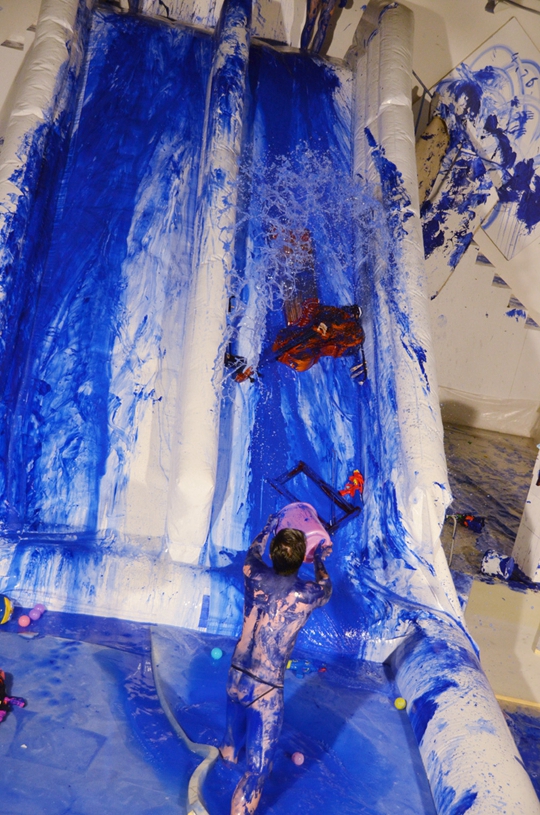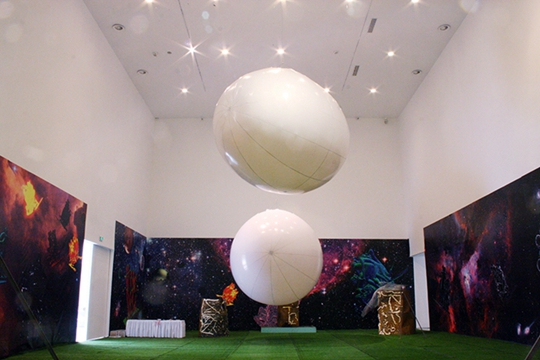DOUBLE FLY
| July 3, 2015 | Post In 2015年6月号

In the ten days before and after the Labor Day holiday, Double Fly Art Center—the collective known for its signature brand of absurd slapstick and carnivalesque live events—rehearsed two clamorous productions: “Double Fly’s Klein Blue” and “Double Fly Egg-crushing Tournament.” The group of nine energetic artists, all 2008 graduates of the new media department of the China Academy of Art, has been active for the past seven years. “Klein Blue” is a no-holdsbarred pirate celebration of a classic art historical work. “Eggcrushing Tournament” is a showbiz-style simulation and outright mockery of today’s phony shanzhai scene. This sort of clear, deliberate rendering of a hysterical atmosphere and staged, yet open performance are part of the overall creative approach that the group carries off, an unrestricted, interactive mode that lends itself to enthusiastic participation on the part of young audiences otherwise absent from conventional exhibition spaces. But the question is: after all of this serious play is over, are the personal dilemmas hidden within the collective expressed or crowded out?

“Double Fly’s Klein Blue” and “Double Fly Egg-crushing Tournament” are not the best spaces for venting feelings or building meaningful dialogue. Symbols that have been over-interpreted by historical texts and folklore threaten to counteract creativity and instead move things toward crowdpleasing flashiness. In 1960, Yves Klein smeared the bodies of nude women with blue pigment and dragged them across his canvas. In 2015, a Chinese artist group performs “blue naked” by playing on inflatable slides. In reality, there is no logical connection other than direct visual reference and simple linguistic juxtaposition. It is even more difficult to determine the conceptual basis for the egg-crushing tournament; the premise—which seems to be ignored entirely—is that, no matter how its form breaks the rules, art is necessarily built on a foundation of serious thought. No shortcut is sufficient to separate artists from the contextually demanding art system to which they are connected. Taking subversion and deconstruction so lightly, it is hard to establish something that can stand up on its own—even with curators making copious allusions to historical and theoretical authorities.

The form of this work is current. It is ideally suited to the age of microblogging and messaging apps, proactively meeting mainstream entertainment with coarse, fragmented, easily digested pop. Compared to the portion of the Chinese contemporary art world that caters to a more mature, elitist niche market, Double Fly set an example with their freewheeling trial-and-error approach, regardless of the bottom line. The effectiveness and value of their strategy is difficult to determine, but it has the courage to replace hit-you-overthe-head thematics and precious theatricality with irrational, cathartic performance.

If it is imperative to find an art historical comparison, it might be said—problematically—that Double Fly is trying hard to play the role of the Guerilla Girls in terms of their use of popular media they use, the clarity of their language, and their devotion to shaping a collective image in the style of an entertainment personality. Formed by a group of anonymous female artists, authors, and filmmakers, the Guerilla Girls took aim at entirely different power structures. Both groups deliberately challenge public opinion through performance, directing attention to different forms of identity politics—still the most difficult thing for the art system to judge.
Text by Zhang Xiyuan
Translated by Katy Pinke

